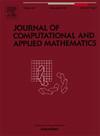伪反转多尺度分析及其在流形值序列中的应用
IF 2.6
2区 数学
Q1 MATHEMATICS, APPLIED
Journal of Computational and Applied Mathematics
Pub Date : 2025-07-24
DOI:10.1016/j.cam.2025.116922
引用次数: 0
摘要
使用流形值建模数据是一个强大的概念,具有许多优点,特别是在处理非线性现象时。这种方法捕获数据的内在几何结构,从而产生更准确的描述符和更有效的计算过程。然而,即使是像压缩和数据增强这样的基本任务,在歧管环境中也面临着重大挑战。本文介绍了一种多尺度变换,旨在表示不同尺度的流形值序列,为各种应用提供了新的数据处理工具。与传统方法类似,我们的构造基于作为上采样算子和相应的下采样算子的细化算子。受维纳引理的启发,我们将后者称为前者的反面。事实证明,一些上采样运算符,例如,基于最小二乘的细化,并没有实际的反转。因此,我们引入了伪反转的概念,并探讨了它的解析性质和渐近性。我们推导了诱导多尺度变换的解析性质,并用数值说明了伪反转的不同方面以及涉及流形的两种数据处理应用。本文章由计算机程序翻译,如有差异,请以英文原文为准。
Multiscale analysis via pseudo-reversing and applications to manifold-valued sequences
Modeling data using manifold values is a powerful concept with numerous advantages, particularly in addressing nonlinear phenomena. This approach captures the intrinsic geometric structure of the data, leading to more accurate descriptors and more efficient computational processes. However, even fundamental tasks like compression and data enhancement present meaningful challenges in the manifold setting. This paper introduces a multiscale transform that aims to represent manifold-valued sequences at different scales, enabling novel data processing tools for various applications. Similar to traditional methods, our construction is based on a refinement operator that acts as an upsampling operator and a corresponding downsampling operator. Inspired by Wiener’s lemma, we term the latter as the reverse of the former. It turns out that some upsampling operators, for example, least-squares-based refinement, do not have a practical reverse. Therefore, we introduce the notion of pseudo-reversing and explore its analytical properties and asymptotic behavior. We derive analytical properties of the induced multiscale transform and conclude the paper with numerical illustrations showcasing different aspects of the pseudo-reversing and two data processing applications involving manifolds.
求助全文
通过发布文献求助,成功后即可免费获取论文全文。
去求助
来源期刊
CiteScore
5.40
自引率
4.20%
发文量
437
审稿时长
3.0 months
期刊介绍:
The Journal of Computational and Applied Mathematics publishes original papers of high scientific value in all areas of computational and applied mathematics. The main interest of the Journal is in papers that describe and analyze new computational techniques for solving scientific or engineering problems. Also the improved analysis, including the effectiveness and applicability, of existing methods and algorithms is of importance. The computational efficiency (e.g. the convergence, stability, accuracy, ...) should be proved and illustrated by nontrivial numerical examples. Papers describing only variants of existing methods, without adding significant new computational properties are not of interest.
The audience consists of: applied mathematicians, numerical analysts, computational scientists and engineers.

 求助内容:
求助内容: 应助结果提醒方式:
应助结果提醒方式:


